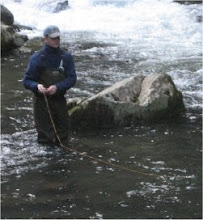There are two reasons the Provo River is crowded: (1) its two tailwater sections are within 45 minutes of half the state's population and (2) it is chock full of fish. Because of this, the fly fishermen in Utah have something of a love-hate relationship with the Provo River. On a Saturday or a weekday afternoon as one drives up Highway 189 alongside the river, it appears as though every pool or run holds a fly fisherman. But there are enough fish (too many fish according to some reports) that skilled anglers can catch fish all year round even when there's a crowd.
If there were such a thing as a blue-collar trout stream, the Provo River would definitely qualify. It's not what you'd call a fly fishing destination (in fact the lower part of the river flows right through the Provo/Orem community near Brigham Young University), but it allows thousands of local fishermen to take off of work an hour early, park right next to the stream, and have a decent chance of catching sizeable fish on a fly at any time of year.
One of the things that intrigues me about the Provo River is that the Lower section of the river is divided into an upper artificial-lure-only section where nearly everyone practices catch-and-release (two fish under fifteen inches long can technically be kept over 98 percent of fish are released) and a lower section (the Lower Lower, as I like to call it) where fishermen can use bait and keep fish according to regular fishing regulations. What has happened over the last couple of decades is that although the population of trout in the Provo has increased, the average size has decreased. Last summer, Bill and I had one of those "legendary" days on the Provo where we probably caught 50 fish between the two of us but I don't think either of us landed one over 18 inches long. (Bill claims to have hooked into a Brown trout that would have measured 21+ but since he was unable to land it, we'll never know). What I do know is that these days, the chances of catching a 20-inch trout on the Provo River are much lower than they used to be--but the tradeoff is that reasonably adept fishermen can often catch a number of fish.
This year, I'm tempted to fish the "Lower" Lower section in hopes that we'll have a better chance of catching some larger fish even though the number of fish per mile will be thinned out somewhat due to harvesting by bait fishermen. We'll have to see what happens.

1 comment:
Cool blog. I learned more about Fly Fishing in these three posts than ever before.
Is Dani still showing interest?
Post a Comment